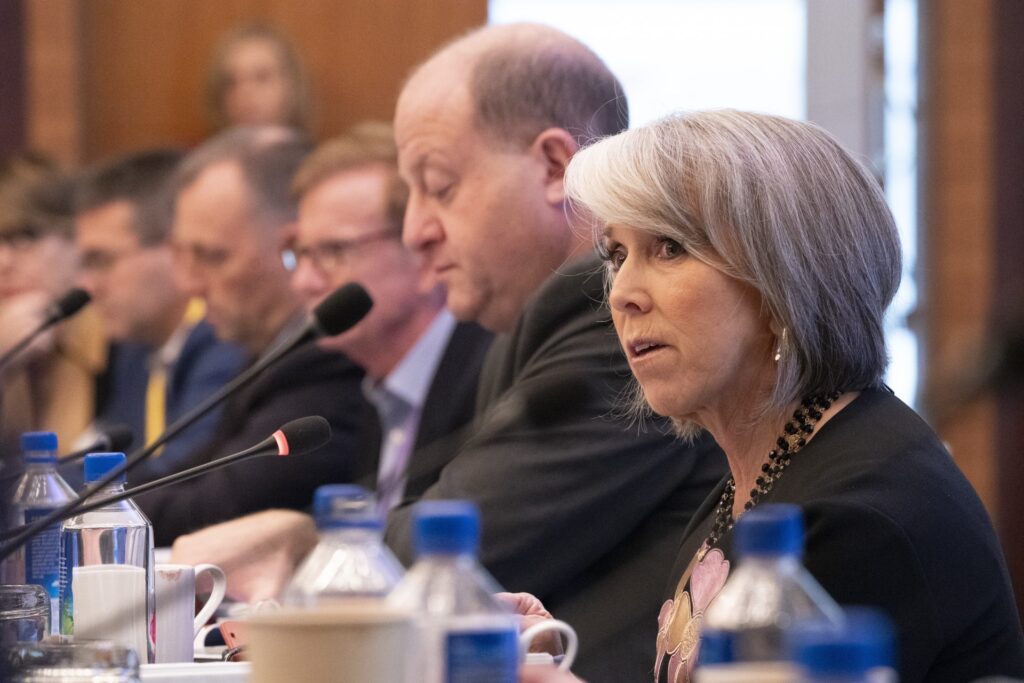Let’s Get Ready: Educating All Americans for Success is designed to support Governors in driving innovation to tackle opportunity gaps that limit economic mobility.
It starts with identifying those gaps. At the initiative’s first regional convening in Denver, NGA Chair Colorado Governor Jared Polis welcomed representatives of the National Assessment of Education Progress (NAEP) to brief Governors on recent trends tracked by “The Nation’s Report Card.”
“It’s important to know where we are and how to fully understand the challenges we face,” Governor Polis stated.
Through assessments administered every four years, NAEP measures academic performance in math, reading and other subjects among 9-, 13-, and 17-year-old students.

Dr. Marty West, Professor of Education at the Harvard Graduate School of Education and a member of the National Assessment Governing Board, which oversees the administration and release of NAEP, was on hand to share an overview of NAEP’s findings. The discussion was moderated by Marlon Marshall, CEO of City Fund – an organization dedicated to providing grant funding in partner cities to give all students, especially those historically denied access, a quality education.
“NAEP is the one common yardstick we have to compare students’ academic performance nationwide and from state to state,” Dr. West explained. “It enables us to answer questions like: How are US students doing academically? How is this generation of students compared to previous generations? And how much progress have different groups of students made over time? We like to say that NAEP lets us tell the stories of American student achievement over time and in context.”
The next edition of NAEP will be released in early 2025, giving states another marker to gauge student progress in recovering from learning loss observed since the COVID-19 pandemic.
When the last Report Card was released in 2022, pandemic learning loss impacts were significant.
“We saw pretty dramatic declines in achievement across grades and subject areas,” Dr. West stated. “Not only did achievement fall, but the declines were largest among our lowest-achieving students – indicating who bore the brunt of the learning loss associated with the pandemic.

While declines were “substantial, pervasive and persistent,” they weren’t entirely new, Dr. West noted.
“I want to remind people, though, that the decade leading up to the pandemic was a decade of relative stagnation, or even a bit of decline, in students’ academic skills,” he explained. “This was a period where we saw overall stagnation. We saw higher-achieving students – those in the 90th percentile, the 75th percentile – holding their own. But we saw lower-performing students actually decline in their achievement quite rapidly. This fanning out of achievement is a trend that began before the pandemic.”
The lesson? “It is a reminder why the goal can’t be just to get back to normal,” Dr. West underlined. “The goal really needs to be to move to a more effective system.”
NAEP also reveals significant deficits in civic education. “Civics and U.S. history are the subject areas in which U.S. students perform worse,” Dr. West shared. NAEP found only 20% of students achieving proficiency in civics – with more than three quarters registering scores at the basic or below basic level. Only one-third of eight graders, for instance, could correctly identify the three branches of government and their functions. “When you ask eighth graders whether they’re spending any time studying these topics, [responses indicate] they’re not,” Dr. West explained. “I don’t think that students are incapable of learning [civics]. We haven’t been focusing attention on it.”

Civics is assessed at the national level by NAEP, rather than state by state. But that is changing, West stated. Starting in 2030, individual states will have the opportunity to participate in a separate civics assessment at no cost.
Dr. West left Governors with advice on how to use NAEP effectively: “Keep expectations. High expectations don’t ensure high levels of achievement, but they have to be part of it. You can understand what’s going on in your own state and learn from states that are likely near you. You can use NAEP data as the foundation for partnerships with higher education, the business community and more.”
Governors are doing just that. During a discussion of their states’ approaches, several Governors shared how they use data and information about employment needs to spur education innovation. Click here for highlights of the Governors’ discussion in Denver, and click here for an overview of education policy priorities Governors presented in their 2024 State of the State addresses.













